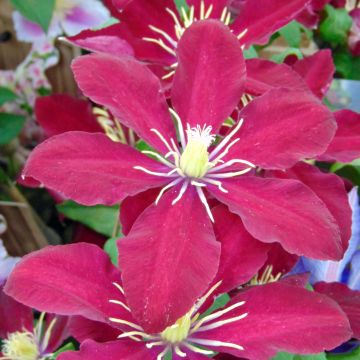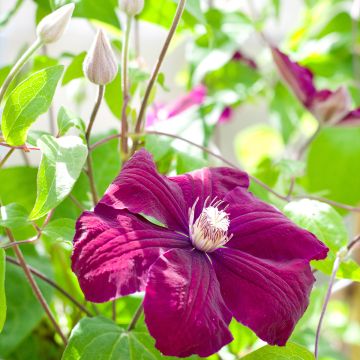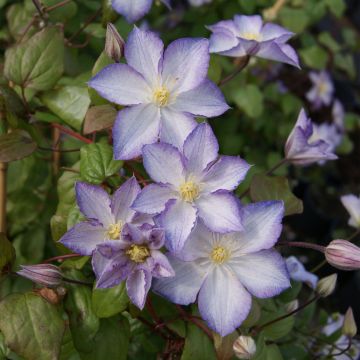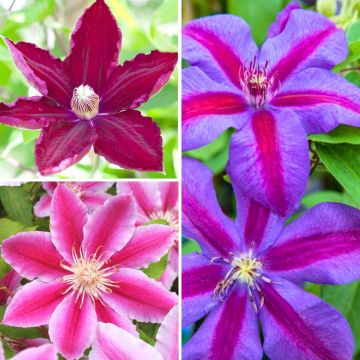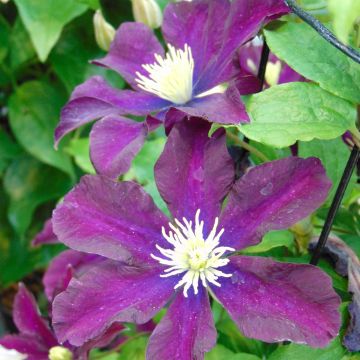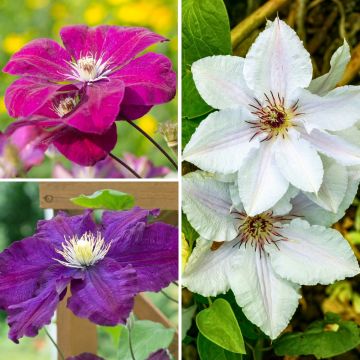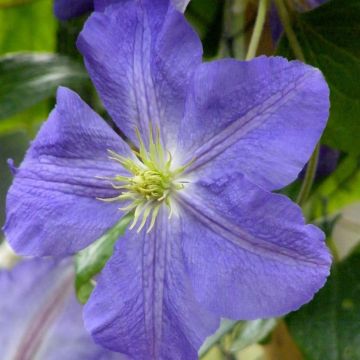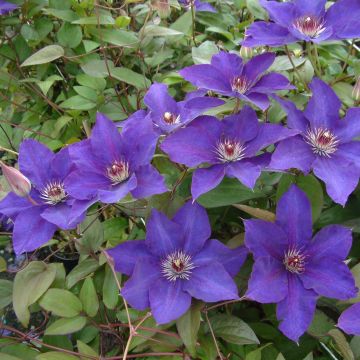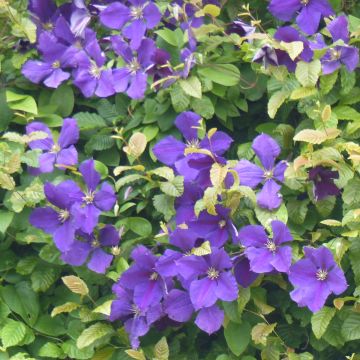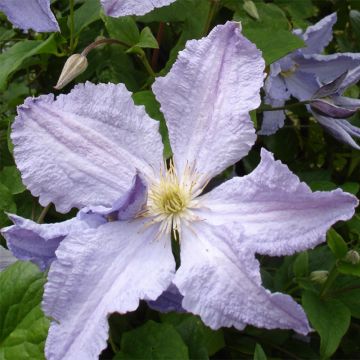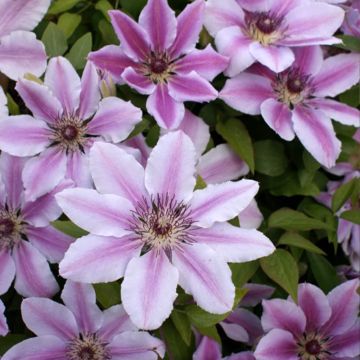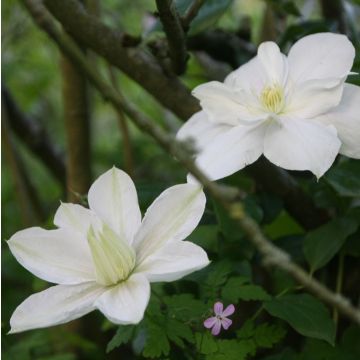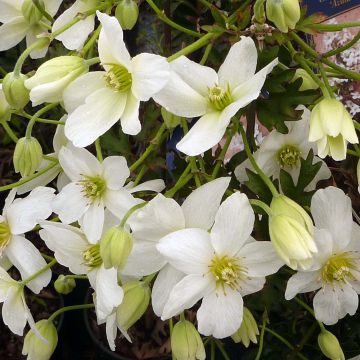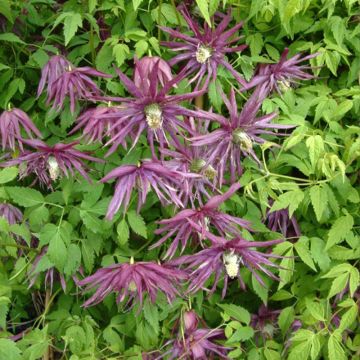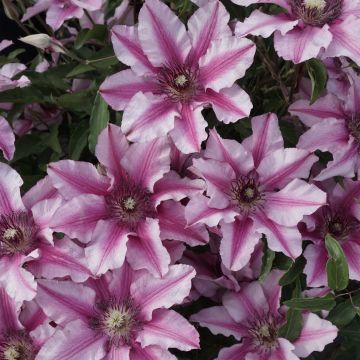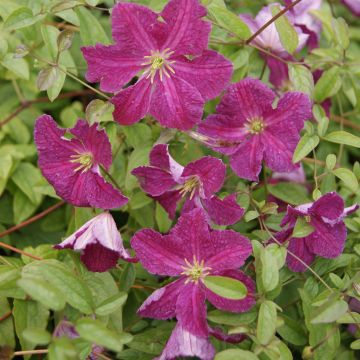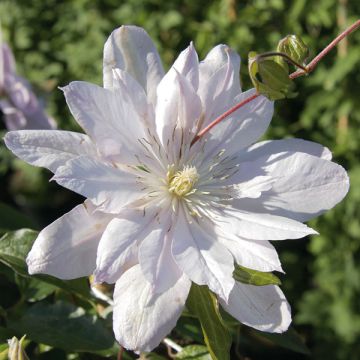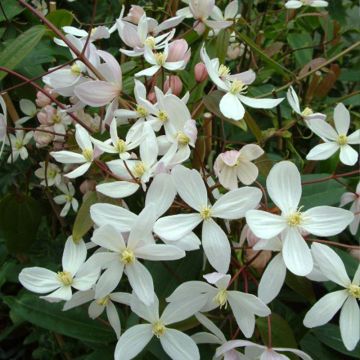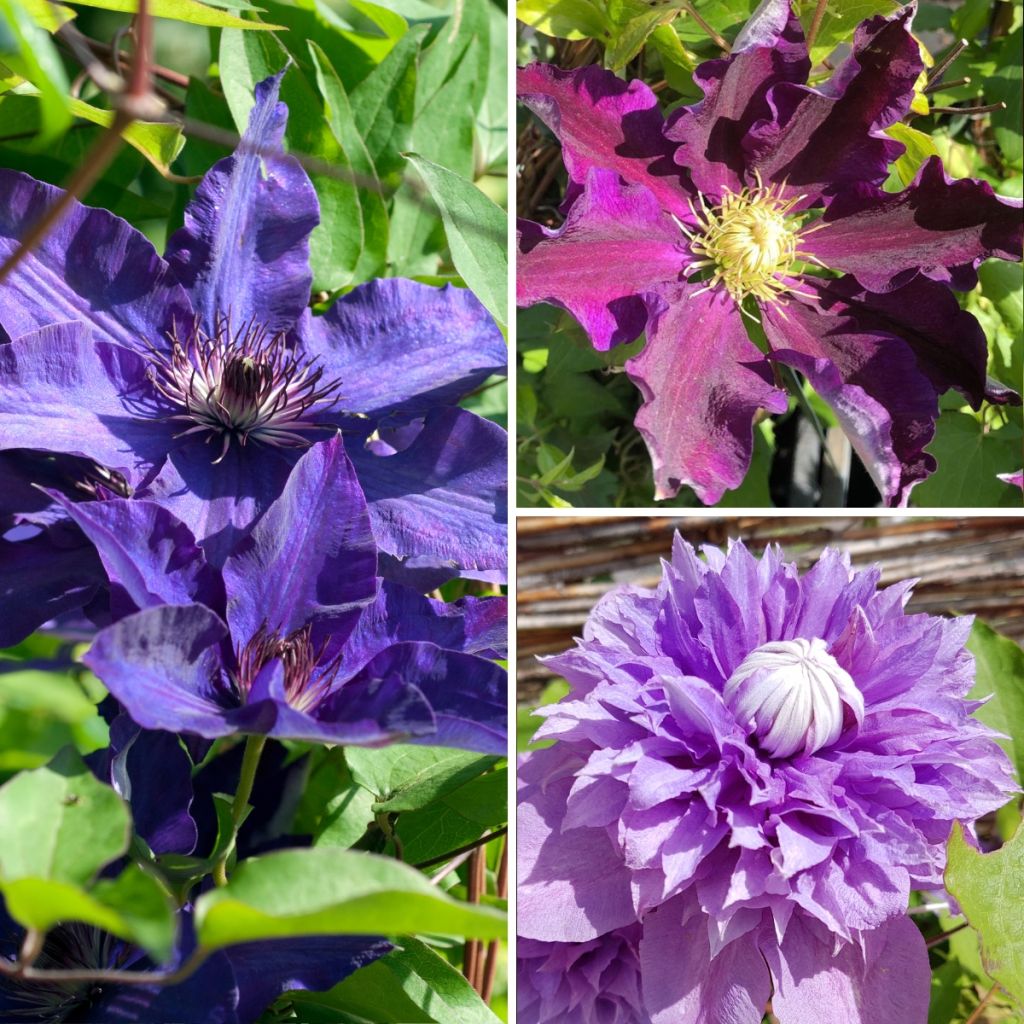

Clematis Three Sisters blue trio- The President, The Vagabond and Multi Blue
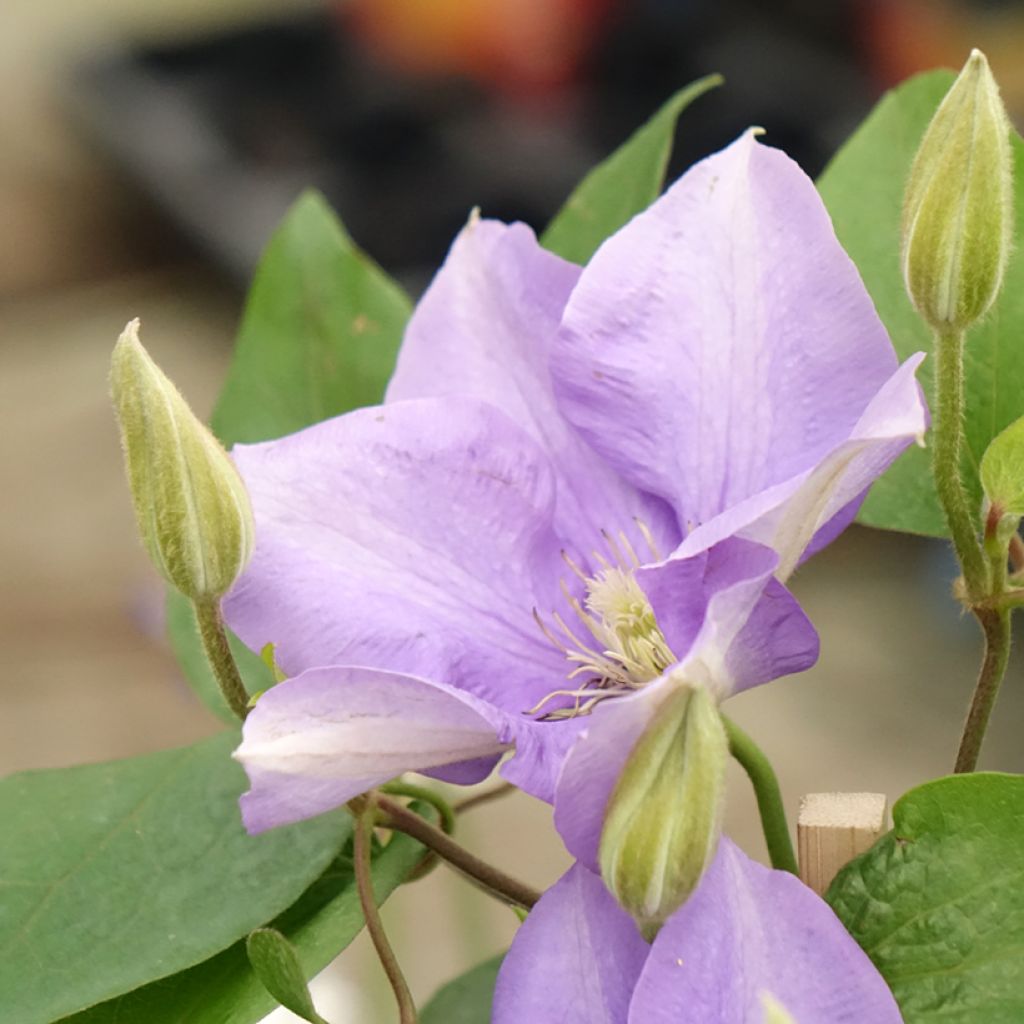

Clematis Three Sisters blue trio- The President, The Vagabond and Multi Blue
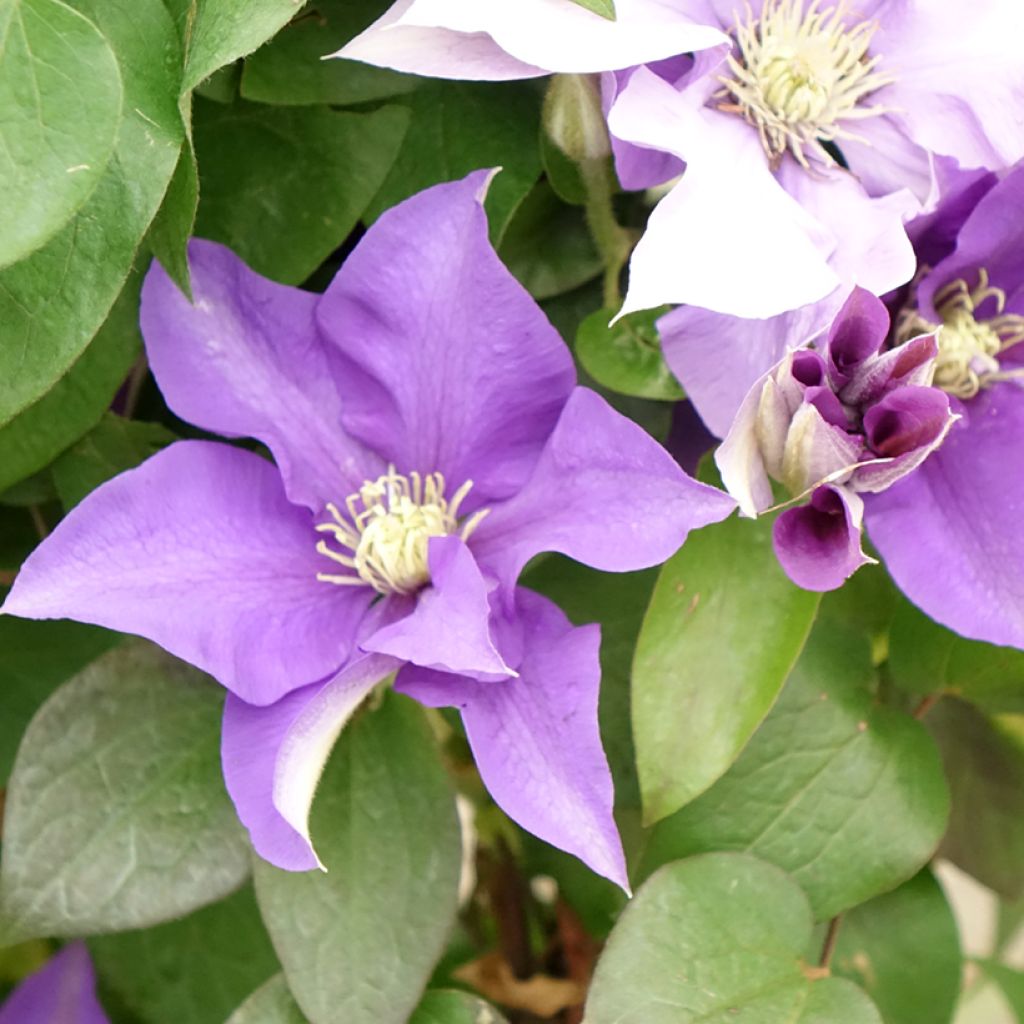

Clematis Three Sisters blue trio- The President, The Vagabond and Multi Blue
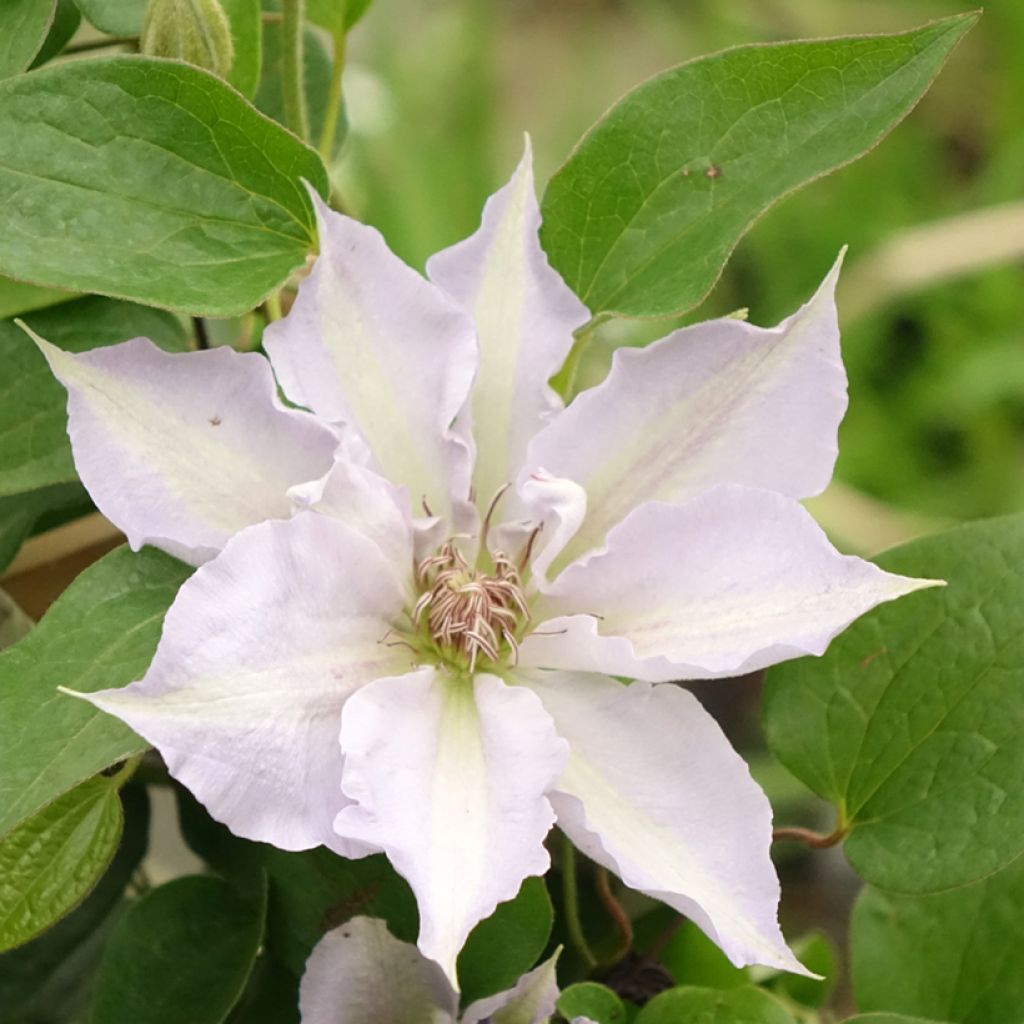

Clematis Three Sisters blue trio- The President, The Vagabond and Multi Blue
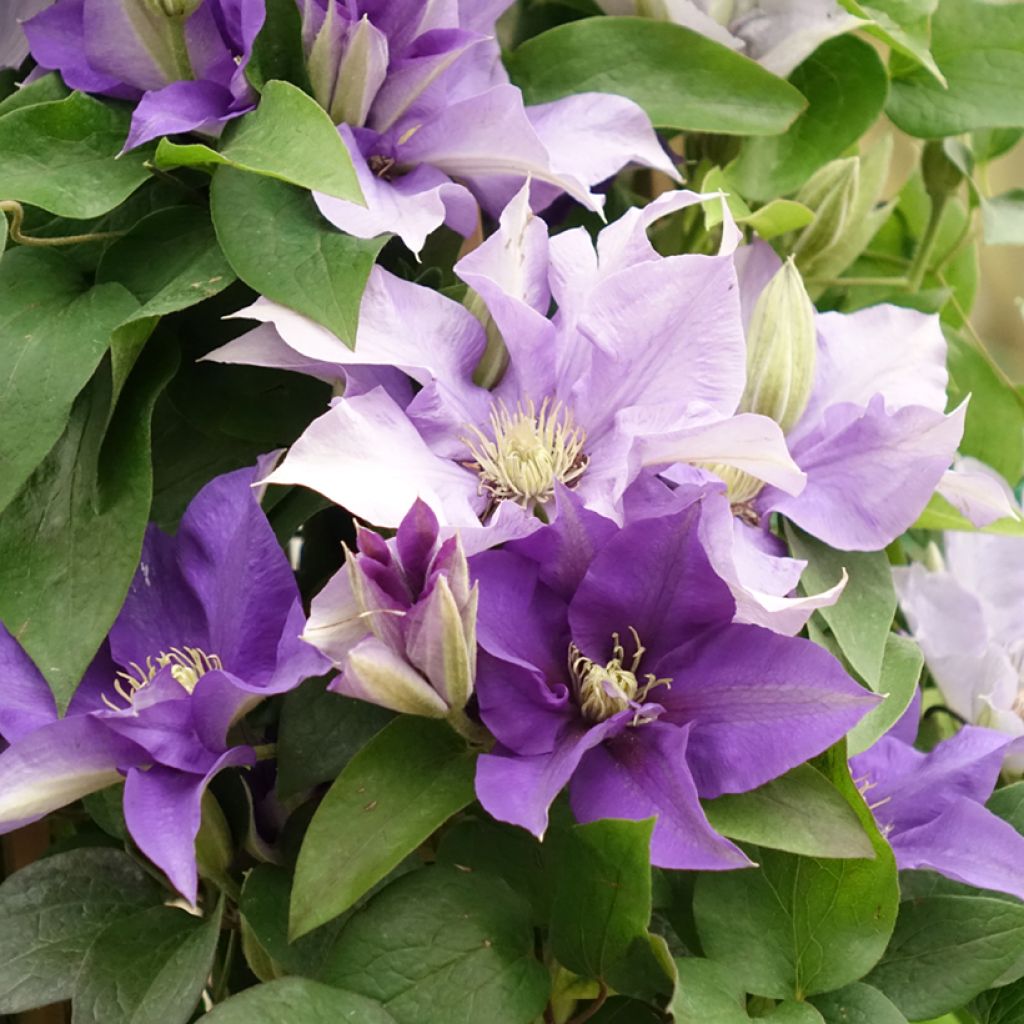

Clematis Three Sisters blue trio- The President, The Vagabond and Multi Blue
Clematis Three Sisters blue trio- The President, The Vagabond and Multi Blue
Clematis Mix Blue
Traveller's Joy, Old Man's Beard, Virgin's Bower
Home or relay delivery (depending on size and destination)
Schedule delivery date,
and select date in basket
This plant carries a 6 months recovery warranty
More information
We guarantee the quality of our plants for a full growing cycle, and will replace at our expense any plant that fails to recover under normal climatic and planting conditions.
Does this plant fit my garden?
Set up your Plantfit profile →
Description
Clematis Three Sisters blue trio is a collection of three deciduous clematis varieties in the same pot, each offering a different shade of blue-violet. 'The President' is an English cultivar, with large single flowers in blue, veined with violet. 'The Vagabond' also comes from England and produces even more impressive flowers, in a very intense purple. 'Multi Blue', originating from the Netherlands, is a mutation with very double flowers of 'The President', which blooms in spring and again in late summer. Compact varieties, reaching 2m or 2.50m, they privide a flowering display from May to September, or even October. Ideal on a sunny balcony or terrace and does not need to be sheltered for winter, as all three are very hardy.
Clematis belong to the family of Ranunculaceae, like columbines or anemones. They are found in Europe, the Himalayas, China, Australia and North and Central America. The genus includes more than 200 species, mostly climbing plants, compact or capable of reaching up to 8m high in trees like Clematis montana, but also some non-climbing herbaceous plants, such as Clematis heracleifolia.
The most difficult thing is often to choose between the beautiful blooms on offer, Three Sisters will delight you with 3 superb varieties, forming a blue-toned harmony. 'The President' is the oldest, an English cultivar, dating back to 1876, credited to Charles Noble, from the Sunningdale nurseries near London. With limited growth, it reaches a maximum of 3m in height and 1.50m in spread. This perpetual variety blooms for the first time in May-June, then again in August-September. It is adorned with large star-shaped, 12 to 15cm diameter, beautiful blue flowers with violet nuances, particularly in the middle part of the tepals. The reverse of the corolla takes on a slightly silvery, decorative hue. The deciduous foliage is initially bronze and gradually turns olive green. Petioles transformed into tendrils allow this plant to grow up on its support.
The second variety in this composition, 'The Vagabond', was created in 1984 in England from a cross between 'Rouge Cardinal' and an unknown variety. It is more compact and does not exceed 2m in free form, which it amply compensates with the size of its flowers: up to 18cm in diameter! Blooming from May to August in large stars, they display an intense purple with a central band of purple-violet for a beautiful effect. The cream-yellow stamen centre is quite large and contrasts nicely with the petals. Its deciduous, ovate, green, 10cm long leaves, are carried by twining stems that coil around their support using tendrils.
'Multi Blue', the third "sister", comes from the Netherlands, from the J. Bouter & Zoon nursery in Boskoop, one of the main production areas in Europe. This cultivar, dating back to 1983, is a mutation of 'The President'. It produces smaller, 8 to 12cm in diameter, but very double flowers, with a variable appearance. The numerous rather tapered tepals form a sort of central pompom, almost mimicking stamens. They can also widen to form multiple concentric circles of increasing diameter, gradually joining the well-spread peripheral sepals. The corolla's centre is made up of a tuft of green stamens. The deep blue-violet flowers with a lighter vein in the centre gradually lighten as they mature. Flowering begins in May, takes a small break in summer, and restarts in September. This small climber, up to 3m high, has foliage tinged with bronze in spring, then turning dark green.
All three are very hardy (beyond -20°C) and will thrive on a terrace, with their heads in the sun and their feet preferably protected from the rays. Of comparable vigour, it will be easy to keep them in pots, but they can also be grown in the ground.
The Three Sisters collection is a beautiful combination of climbers with generous blooms that will ensure a long flowering season. Repotted in a decorative terracotta pot, they can spend the winter outdoors. Maintenance will consist of removing fallen leaves from the floor and a cleaning pruning in spring. To accompany them, you can place Trailing Fuchsia Maori Maid that will give you a magnificent flowering pot. Its large double flowers (up to 7cm), red and purple, will gracefully cascade throughout the summer and until October. To further extend the flowering period, nothing beats Forsythia Mikador which can be kept in a pot due to its compact size. In March-April, it will reward you with lots of yellow flowers, before the large stars of your clematis.
Report an error about the product description
Clematis Three Sisters blue trio- The President, The Vagabond and Multi Blue in pictures
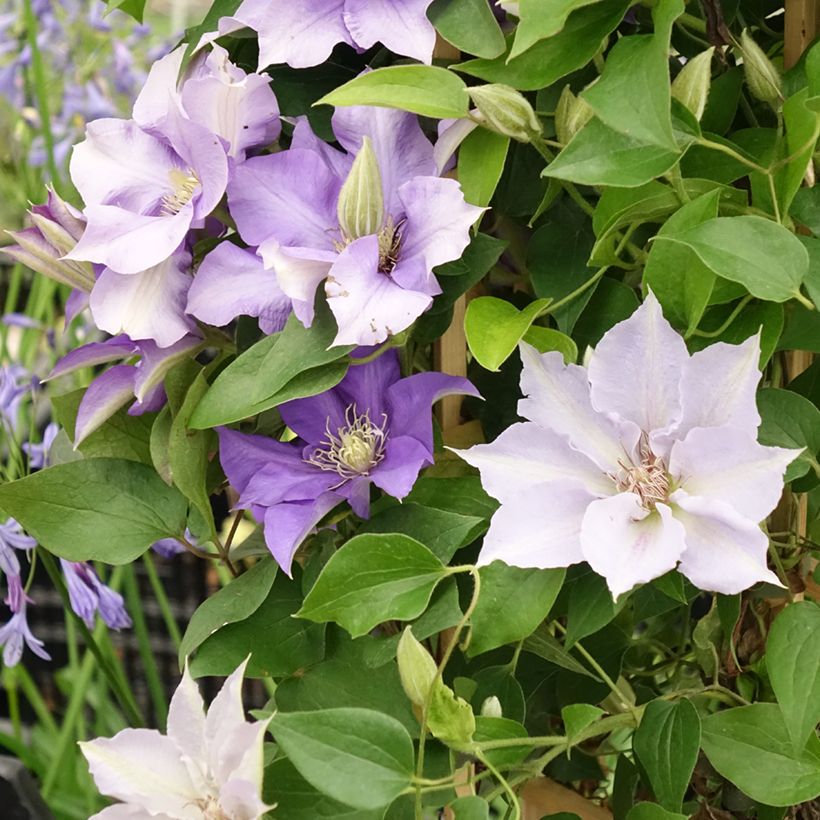

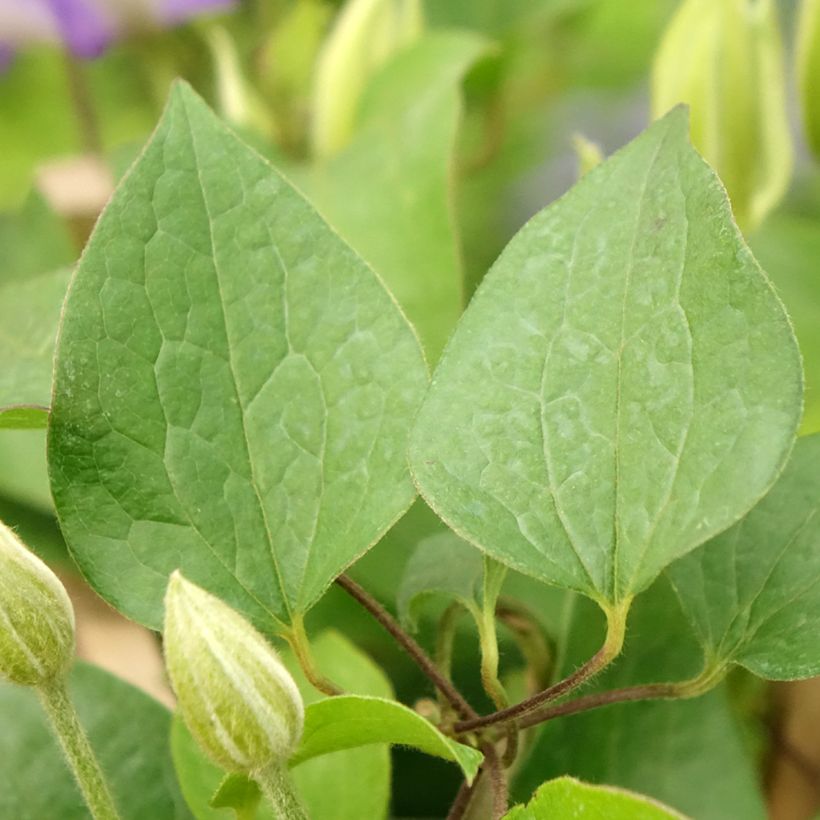

Plant habit
Flowering
Foliage
Safety measures
Botanical data
Clematis
Mix Blue
Ranunculaceae
Traveller's Joy, Old Man's Beard, Virgin's Bower
Cultivar or hybrid
atteintescutaneomuqueuses
Cette plante peut provoquer l'apparition de réactions cutanées indésirables, une atteinte des yeux, ou des difficultés respiratoires si elle est ingérée.
Ne la plantez pas là où de jeunes enfants peuvent évoluer. Evitez tout contact avec la peau: privilégiez l'emploi de gants pour la manipuler. En cas de contact, lavez-vous soigneusement les mains et rincez abondamment à l'eau la zone concernée. Lavez les vêtements entrés en contact. En cas de réaction cutanée, contactez votre médecin ou le centre antipoison le plus proche de chez vous. En cas d'atteinte étendue ou de difficultés respiratoires, appelez immédiatement le 15 ou le 112.Pensez à conserver l'étiquette de la plante, à la photographier ou à noter son nom, afin de faciliter le travail des professionnels de santé.
Davantage d'informations sur https://plantes-risque.info
Other Clematis Jackmanii
View all →Planting and care
This Clematis collection will appreciate a sunny or light shade position. Plant it in a fertile, humus-rich, well-drained soil, shading the roots and the base of the stem (with a flat tile, for example). Clematis can wilt in overly wet soil. Plant it, with the root ball at an angle, covering it with 3 cm of soil, in a worked soil, lightened with good compost and coarse sand. After planting, cut back the clematis stems to about 30 cm from the base above a nice pair of buds. In the first few weeks, water regularly. However, be careful not to let the water stagnate as this can cause a fungus to develop at the neck. Mulch all clematis in February with garden compost or well-rotted manure, avoiding direct contact with the stems. Train the stems, without crushing them, until the plant grips itself. Clematis also like to grow freely on neighbouring plants. After a few years, cover the base of your climbing clematis with a small mound of soil to reduce the risk of wilting while promoting the growth of vigorous shoots from the stump. Slugs can attack clematis and devour the stems. Aphids and greenhouse whiteflies are also potential peats.
Planting period
Intended location
Care
This item has not been reviewed yet - be the first to leave a review about it.
Similar products
Haven't found what you were looking for?
Hardiness is the lowest winter temperature a plant can endure without suffering serious damage or even dying. However, hardiness is affected by location (a sheltered area, such as a patio), protection (winter cover) and soil type (hardiness is improved by well-drained soil).

Photo Sharing Terms & Conditions
In order to encourage gardeners to interact and share their experiences, Promesse de fleurs offers various media enabling content to be uploaded onto its Site - in particular via the ‘Photo sharing’ module.
The User agrees to refrain from:
- Posting any content that is illegal, prejudicial, insulting, racist, inciteful to hatred, revisionist, contrary to public decency, that infringes on privacy or on the privacy rights of third parties, in particular the publicity rights of persons and goods, intellectual property rights, or the right to privacy.
- Submitting content on behalf of a third party;
- Impersonate the identity of a third party and/or publish any personal information about a third party;
In general, the User undertakes to refrain from any unethical behaviour.
All Content (in particular text, comments, files, images, photos, videos, creative works, etc.), which may be subject to property or intellectual property rights, image or other private rights, shall remain the property of the User, subject to the limited rights granted by the terms of the licence granted by Promesse de fleurs as stated below. Users are at liberty to publish or not to publish such Content on the Site, notably via the ‘Photo Sharing’ facility, and accept that this Content shall be made public and freely accessible, notably on the Internet.
Users further acknowledge, undertake to have ,and guarantee that they hold all necessary rights and permissions to publish such material on the Site, in particular with regard to the legislation in force pertaining to any privacy, property, intellectual property, image, or contractual rights, or rights of any other nature. By publishing such Content on the Site, Users acknowledge accepting full liability as publishers of the Content within the meaning of the law, and grant Promesse de fleurs, free of charge, an inclusive, worldwide licence for the said Content for the entire duration of its publication, including all reproduction, representation, up/downloading, displaying, performing, transmission, and storage rights.
Users also grant permission for their name to be linked to the Content and accept that this link may not always be made available.
By engaging in posting material, Users consent to their Content becoming automatically accessible on the Internet, in particular on other sites and/or blogs and/or web pages of the Promesse de fleurs site, including in particular social pages and the Promesse de fleurs catalogue.
Users may secure the removal of entrusted content free of charge by issuing a simple request via our contact form.
The flowering period indicated on our website applies to countries and regions located in USDA zone 8 (France, the United Kingdom, Ireland, the Netherlands, etc.)
It will vary according to where you live:
- In zones 9 to 10 (Italy, Spain, Greece, etc.), flowering will occur about 2 to 4 weeks earlier.
- In zones 6 to 7 (Germany, Poland, Slovenia, and lower mountainous regions), flowering will be delayed by 2 to 3 weeks.
- In zone 5 (Central Europe, Scandinavia), blooming will be delayed by 3 to 5 weeks.
In temperate climates, pruning of spring-flowering shrubs (forsythia, spireas, etc.) should be done just after flowering.
Pruning of summer-flowering shrubs (Indian Lilac, Perovskia, etc.) can be done in winter or spring.
In cold regions as well as with frost-sensitive plants, avoid pruning too early when severe frosts may still occur.
The planting period indicated on our website applies to countries and regions located in USDA zone 8 (France, United Kingdom, Ireland, Netherlands).
It will vary according to where you live:
- In Mediterranean zones (Marseille, Madrid, Milan, etc.), autumn and winter are the best planting periods.
- In continental zones (Strasbourg, Munich, Vienna, etc.), delay planting by 2 to 3 weeks in spring and bring it forward by 2 to 4 weeks in autumn.
- In mountainous regions (the Alps, Pyrenees, Carpathians, etc.), it is best to plant in late spring (May-June) or late summer (August-September).
The harvesting period indicated on our website applies to countries and regions in USDA zone 8 (France, England, Ireland, the Netherlands).
In colder areas (Scandinavia, Poland, Austria...) fruit and vegetable harvests are likely to be delayed by 3-4 weeks.
In warmer areas (Italy, Spain, Greece, etc.), harvesting will probably take place earlier, depending on weather conditions.
The sowing periods indicated on our website apply to countries and regions within USDA Zone 8 (France, UK, Ireland, Netherlands).
In colder areas (Scandinavia, Poland, Austria...), delay any outdoor sowing by 3-4 weeks, or sow under glass.
In warmer climes (Italy, Spain, Greece, etc.), bring outdoor sowing forward by a few weeks.



































